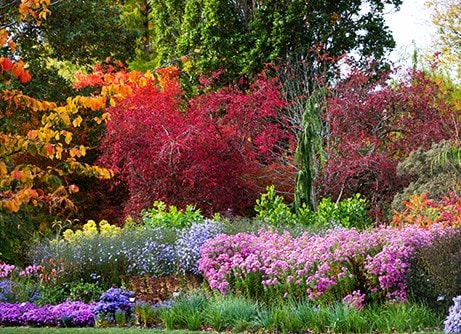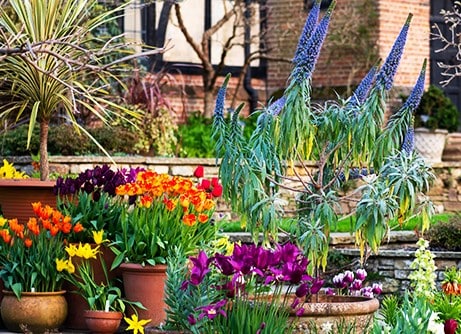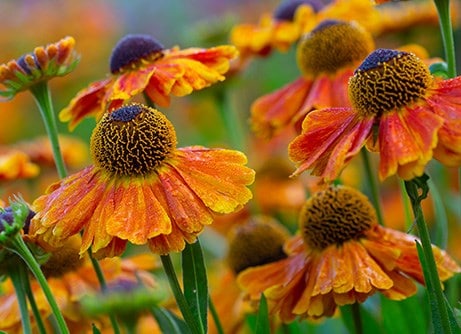
Bold, tropical foliage makes this canna a striking addition to gardens and containers. Large, banana-like leaves in veined shades of deep purple, pink, and green create an architectural display, providing a dramatic backdrop for its vibrant red flowers.
Blooming from mid-summer to autumn, the fiery blossoms stand out in borders, pots, and water-side plantings. This tender perennial thrives in moist, rich, well-drained soil and prefers a sunny, sheltered position.
Growing up to 1.5m tall with a spread of around 60cm, it adds vertical interest and works well as a focal point.
Canna 'Tropicana Red' is perfect for bold planting schemes, whether used in mass displays, narrow spaces, or large statement containers.
Blooming from mid-summer to autumn, the fiery blossoms stand out in borders, pots, and water-side plantings. This tender perennial thrives in moist, rich, well-drained soil and prefers a sunny, sheltered position.
Growing up to 1.5m tall with a spread of around 60cm, it adds vertical interest and works well as a focal point.
Canna 'Tropicana Red' is perfect for bold planting schemes, whether used in mass displays, narrow spaces, or large statement containers.
How to care for Canna Tropicana Red (PBR):
Pot the rhizomes up into 20cm pots filled with a good quality compost. The rhizomes should be planted shallowly, just covering them with compost, but making sure that any new shoots are above soil level.
Water lightly and then grow them on at temperatures above 15°C, increasing the water as they start to grow. Gradually harden off before planting out after all risk of frost has passed. Water regularly during the growing season, applying a phosphorus-rich liquid fertiliser each month.
In frost-prone areas lift the rhizomes in autumn and store in a frost-free environment in barely-moist compost or leaf mould.
Cannas thrive in moist, well-drained soil, so regular watering is essential, especially during dry spells. Container-grown plants may need daily watering in hot weather to prevent drying out.
Once established, apply a slow-release fertiliser in spring, followed by a high-potassium liquid feed every 2–3 weeks during the growing season to encourage strong growth and prolonged flowering.
A 5-7cm (2-3in) mulch layer of well-rotted compost will help to retain moisture, suppress weeds, and improve soil quality. Deadhead spent flowers to promote continuous blooming and remove any damaged or yellowing leaves to keep plants looking their best.
In exposed areas, tall stems may require light staking to prevent breakage. Cut plants back to 10cm (4in) in late autumn, and lift rhizomes or move pots indoors before frost to ensure overwintering success.
Water lightly and then grow them on at temperatures above 15°C, increasing the water as they start to grow. Gradually harden off before planting out after all risk of frost has passed. Water regularly during the growing season, applying a phosphorus-rich liquid fertiliser each month.
In frost-prone areas lift the rhizomes in autumn and store in a frost-free environment in barely-moist compost or leaf mould.
Cannas thrive in moist, well-drained soil, so regular watering is essential, especially during dry spells. Container-grown plants may need daily watering in hot weather to prevent drying out.
Once established, apply a slow-release fertiliser in spring, followed by a high-potassium liquid feed every 2–3 weeks during the growing season to encourage strong growth and prolonged flowering.
A 5-7cm (2-3in) mulch layer of well-rotted compost will help to retain moisture, suppress weeds, and improve soil quality. Deadhead spent flowers to promote continuous blooming and remove any damaged or yellowing leaves to keep plants looking their best.
In exposed areas, tall stems may require light staking to prevent breakage. Cut plants back to 10cm (4in) in late autumn, and lift rhizomes or move pots indoors before frost to ensure overwintering success.
Flowering period:
- Jan
- Feb
- Mar
- Apr
- May
- Jun
- Jul
- Aug
- Sep
- Oct
- Nov
- Dec
Eventual height:
1.5m
Eventual spread:
0.6m
Position:
Full sun
Rate of growth:
Fast-growing
Soil:
Moderately fertile, moist but well-drained soil, or peat-free general purpose compost
Hardiness:
Frost tender
-
This bulb dies back after flowering each year and enters a period of rest ahead of regrowth the following season.
-
Humans/Pets: Ornamental bulbs - not to be eaten
Product options

1 × rhizome
£8.99
available to order from winter
Unavailable

3 × rhizomes
£26.97
£8.99 each
available to order from winter
Unavailable
1
Delivery options (pick your preferred option at checkout)
Bulbs (only)£4.99









